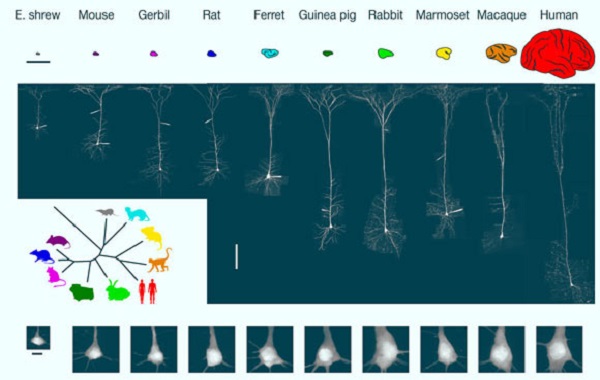Human Neurons are Strikingly Different from Those of Other Mammals, Study Says
Human neurons have a much smaller number of channels that control the flow of ions (such as potassium and sodium) than expected, compared to the neurons of other mammals, according to new research led by MIT neuroscientists; and this reduction in channel density may have helped the human brain evolve to operate more efficiently, allowing it to divert resources to other energy-intensive processes that are required to perform complex cognitive tasks.
Neurons in the mammalian brain can receive electrical signals from thousands of other cells, and that input determines whether or not they will fire an electrical impulse called an action potential.
In 2018, MIT researcher Mark Harnett and colleagues discovered that human and rat neurons differ in some of their electrical properties, primarily in parts of the neuron called dendrites — tree-like antennas that receive and process input from other cells.
One of the findings from that study was that human neurons had a lower density of ion channels than neurons in the rat brain.
The researchers were surprised by this observation, as ion channel density was generally assumed to be constant across species.
In their new study, the scientists decided to compare neurons from several different mammalian species to see if they could find any patterns that governed the expression of ion channels.
They studied two types of voltage-gated potassium channels and the HCN channel, which conducts both potassium and sodium, in layer 5 pyramidal neurons, a type of excitatory neurons found in the brain’s cortex.
They were able to obtain brain tissue from 10 mammalian species: Etruscan shrews (one of the smallest known mammals), gerbils, mice, rats, Guinea pigs, ferrets, rabbits, marmosets, and macaques, as well as human tissue removed from patients with epilepsy during brain surgery.
This variety allowed the team to cover a range of cortical thicknesses and neuron sizes across the mammalian kingdom.
The authors found that in nearly every mammalian species they looked at, the density of ion channels increased as the size of the neurons went up.
The one exception to this pattern was in human neurons, which had a much lower density of ion channels than expected.
“The increase in channel density across species was surprising, because the more channels there are, the more energy is required to pump ions in and out of the cell,” Dr. Harnett said.
“However, it started to make sense once we began thinking about the number of channels in the overall volume of the cortex.”
In the tiny brain of the Etruscan shrew, which is packed with very small neurons, there are more neurons in a given volume of tissue than in the same volume of tissue from the rabbit brain, which has much larger neurons.
But because the rabbit neurons have a higher density of ion channels, the density of channels in a given volume of tissue is the same in both species, or any of the nonhuman species the researchers analyzed.
“This building plan is consistent across nine different mammalian species,” Dr. Harnett said.
“What it looks like the cortex is trying to do is keep the numbers of ion channels per unit volume the same across all the species. This means that for a given volume of cortex, the energetic cost is the same, at least for ion channels.”
The human brain represents a striking deviation from this building plan, however.
Instead of increased density of ion channels, the authors found a dramatic decrease in the expected density of ion channels for a given volume of brain tissue.
They believe this lower density may have evolved as a way to expend less energy on pumping ions, which allows the brain to use that energy for something else, like creating more complicated synaptic connections between neurons or firing action potentials at a higher rate.
“We think that humans have evolved out of this building plan that was previously restricting the size of cortex, and they figured out a way to become more energetically efficient, so you spend less ATP per volume compared to other species,” Dr. Harnett said.
Source: Sci-news
In a First, Scientists Track 1 Million Neurons Near-Simultaneously in a Mouse Brain
Human Neurons are Strikingly Different from Those of Other Mammals, Study Says

